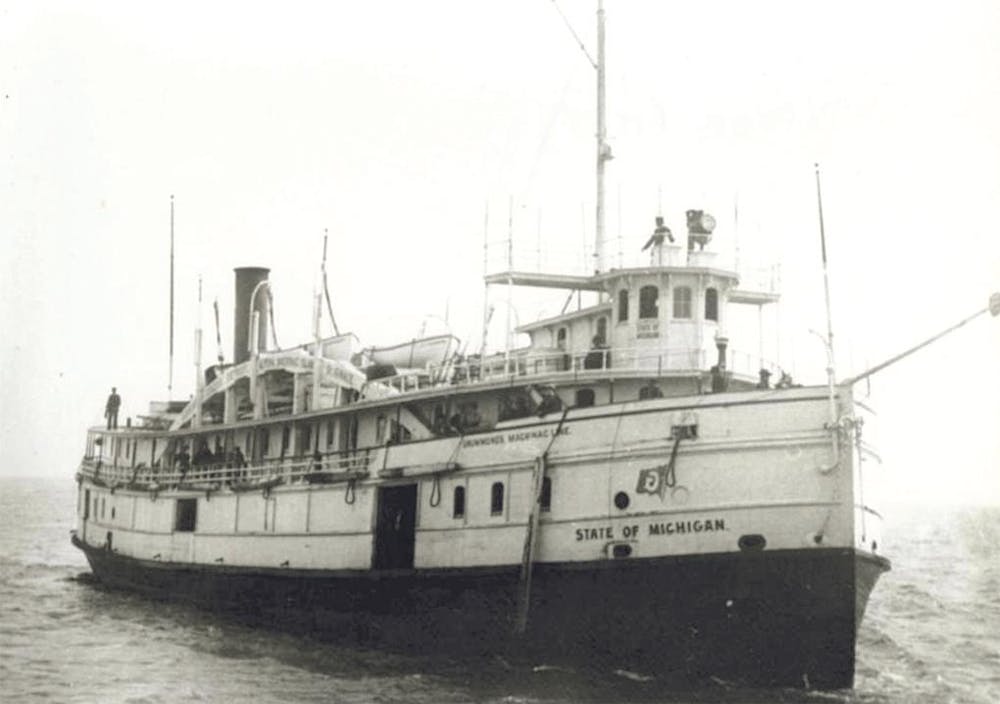In 1873 Captain A. E. Goodrich of Chicago, Illinois, had Rand & Burger of Manitowoc, Wisconsin, build a 165-foot propeller for his Goodrich Steamship Line. The cost to build the vessel was reportedly $57,200. It was given the name Depere. It was used to transport passengers and packaged freight.
After serving the Goodrich Line, the Depere was sold to Stephen B. Grummond in 1892 for $20,000. It was then that her name was changed to State of Michigan. She was put into service on the Detroit-Mackinaw route. By 1897, she was laid up in Canada and made available for purchase.
The State of Michigan was then sold to the Barry Line of Chicago in 1900 for $19,000. She was valued at $30,000 and was insured for $20,000.
On Thursday, Oct. 17, 1901, on the last trip of the season, she left the Muskegon harbor for Manistee with a cargo of salt. At 3 a.m. Friday morning, Oct. 18, when off White Lake, a piston rod from the engine broke and put a hole through the bottom of the boat. The water poured in with such force and volume that the engine hands were driven from the engine room.
Chief Engineer M. R. Burns was startled by the crash in the hold below him and the boat trembled throughout. Standing in front of the engine throttle at the time, he immediately shut down the machinery and headed below to investigate. He nearly reached the bottom of the hold and was startled to see lake water rushing in through a jagged hole in the ship’s timbers. He gave the alarm, and the pumps were started but it soon became apparent that they were totally inadequate for the job. Inside of 15 minutes, the water reached the furnace fires and it was realized by all on board that there was no hope for the Michigan.
Two of the three lifeboats were quickly manned. Eight members of the crew in one boat started for the Life Saving station for the purpose of getting a tug and making an attempt to tow the sinking boat toward shore before she went down.
The remainder of the crew in the other lifeboat made a futile attempt to attract the attention of the lookout at the Life Saving station by saturating a quantity of waste materials with oil and burning it. The signal was not seen, however, as the sinking craft was about four miles northwest of the White River harbor entrance.
The Life Saving station was reached by crewmen of the first lifeboat. Captain Lysaght, some of his men and the crew of the Michigan boarded the tug McGraft, which was laying up in the channel at the time.
Upon reaching the scene of the disaster, a line was fastened to the Michigan, and for over an hour the McGraft worked at towing her nearer the shore. The ferry Eleanor also came and had a line on the Michigan. Within two to three miles northwest of the pier entrance, however, she plunged 80 feet beneath the waves and her work was done forever.
Members of the crew lost nearly everything they owned, that which they saved being only what they had on their person at the time of the accident. Returning to the Life Saving station, the Captain and crew were taken to Montague, where Landlord Peck of the Franklin House made them comfortable.
It was lucky the old boat went down as she did, for had the same accident occurred during the passenger season many would have probably been lost. The Michigan was on the Chicago to Grand Haven route all summer.
In the summer of 1908, the Staud-Canalon Salvage Company went to work to salvage and raise the sunken steamer. By mid-autumn the salvage crew reported the wreck was covered in hundreds of tons of white sand, and was unable to be raised.















